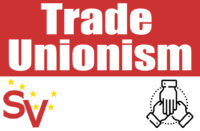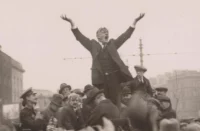The job of trade unionists is to fight the cause of the workers
“An Act to Make Further and Better Provision for Promoting Harmonious Relations between Workers and Employers . . .” reads the long title of the Industrial Relations Act (1990), and its predecessors and amendments.
The use of the phrase “harmonious relations” is telling: it eradicates the nature of class struggle. But the competing and conflicting nature of the demands of workers and employers can be anything but harmonious in a capitalist system.
Under these acts there is no true right to strike. A picket at a place of employment, under certain conditions (peacefully, and in furtherance of a trade dispute), is immune from legal consequences; but that’s about it.
Those immunities don’t stretch very far either. It doesn’t allow for strikes of a political nature, solidarity strikes, or general strikes; and there is a list of criteria that the unions must meet before a picket can even be considered immune.
“Harmonious” in this case seems to mean a quiet worker, a worker who is funnelled into the Workplace Relations Commission and happy to be invited to sit at the table where decisions in their favour are non-binding and largely unenforced.
The 1990 act itself is not to blame for the declining trade union movement. It is, however, indicative of a well-worn passivity within the unions. For such an act to be introduced with little or (at present) no challenge to it shows that a loss of density is more a symptom of an already blighted structure than the problem itself.
Repealing the 1990 act would not just make it easier to strike: it would challenge the ideology behind the act and the atmosphere that allows it to continue.
One of the effects of the act not often remarked on is its reinforcing of the atomising of the worker (i.e. union member) and their work-place disputes from society as a whole, in effect isolating them. Instead of being linked to a larger pattern of resistance, each strike is treated as a distinct issue, divorced from other social or economic discussions.
This is an intentional effort to promote the separation of the political and community spheres of life from the work-place and to disempower workers and their organisations. When workers and unions cannot openly draw the links between the housing crisis, water charges, social welfare cuts and other issues that affect members in their personal lives and their own work-place issues of low pay, bad contracts, and worsening conditions, it stunts the opportunity of raising class-consciousness and mutes dissent to the neo-liberal “common sense” arguments.
It kills solidarity at the root when workers cannot reach out to other organisations or their communities or foster education, understanding, and support.
The worker is a worker and a union member even when not at work.
No longer do we have unions that rely on the education and mobilising of their members to challenge an oppressive wage-labour system: we have insurance policies. It makes sense that under this system a union could have an excellent shop steward in a work-place who still votes for Fianna Fáil or Fine Gael, and see no contradiction in that. This situation should be an anomaly but is commonplace, even in the most left-wing of unions.
Right of access and collective bargaining are important and should be fought for, but they will not solve the ideological gap. The repeal of the 1990 act would be a first step towards challenging this.
The lack of industrial action is a telltale sign of workers feeling powerless and ideologically adrift.
With the rise of precarious employment, members outside the traditional unionised industries are left wondering why they pay their membership dues when they rarely feel the strength of numbers behind them. They are left asking themselves how they can convince other workers to join when unions seem to be built around the already unionised. For organisations built on membership there has been a stark absence of effort in new industries for unionisation, industries rife with exploitation.
This is a “brave new world” of work that has modelled itself on the queues of labourers of the past; and though many of these workers sit at computers or tills, or stand at coffee machines, they are just as insecure as their predecessors. There is an overwhelming number of workers now on year-to-year contracts, some with probationary periods renewed on each signing.
There is also a generation who do not know what unions are. For them, getting a union representative in the door is a great start, but right of access to employers who embrace precariousness of the work force is not one negotiated with through a court that is a showpiece. To organise a precarious work-place you have to be able to offer the employees more than the chance to be formally ignored—they already have that, through company employee representatives.
Workers in precarious situations need to use spontaneity to their advantage. It’s the only real advantage they have.
Why should Tesco or Dunne’s or any other employer be given at least one week in which to prepare for a strike, when they need give no notice before terminating employment? With the only power of workers being the withdrawal of labour, any legislation that reduces the efficacy of that, that gives employers time to prepare scabs, write press statements, or apply political pressure through the usual gombeen structures, is one that a union should be fighting against tooth and nail.
Strikes are expensive for unions, and an ill-timed one can have disastrous consequences; but a lack of one can be just as bad, and can have consequences as far-reaching. So why give the already powerful opponent an advantage?
Some of the most powerful strikes of the recent past cannot be replicated—not only because of a changing environment but because they have been virtually outlawed. Our job as trade unionists—officials, officers, activists, or members—is to fight the cause of the workers, and that cannot be done by agreeing to work under legislation that is written by the enemy.
There are aspects of the 1990 act that can be useful for a union to employ, but it should be the union’s decision when, or if, to use them. To lose sight of this is to forget who is writing the rules in the first place. We should not be looking to any act or law to protect us as workers, or to tell us how to fight, unless we write them!
Almost every piece of governmental industrial legislation introduced has implicitly the intention of weakening the workers’ movement. It’s obvious that any benefit to workers or unions is incidental, or a placatory measure. We only have the withdrawal of labour and the solidarity of our class, both of which the Industrial Relations Act attempts to soften.
The resurgence of anti-union work-place presentations, the use of strike-breakers, blocking union representatives from company premises, lock-outs, and firing without notice if on probationary contract (which can be a full year in length) are all legal.
There is no legal obligation on an employer to negotiate with a union, or to implement the recommendations of the Workplace Relations Commission. There is no law against the creation of yellow-pack staff organisations to get around unions, or firing a worker for taking part in a strike, as long as everyone striking is fired. There is no obligation for social welfare payments to be made available to a striking worker, and no obligation on an employer to pay them.
The Government introduced the Industrial Relations (Amendment) Act (2012), which permits joint labour committees to fix pay rates but requires them to account for the interest of employers and “the need to maintain competitiveness.” It also allows employers to be exempted from the rates in the case of financial difficulties—meaning that nothing happens unless employers agree to it.
Employers are neither friends nor a benevolent force for their employees, and neither is the legislation that protects them and the system of exploitation, no matter the veneer on it. It’s like thinking that a landlord as a housing minister makes sense for the renter.






